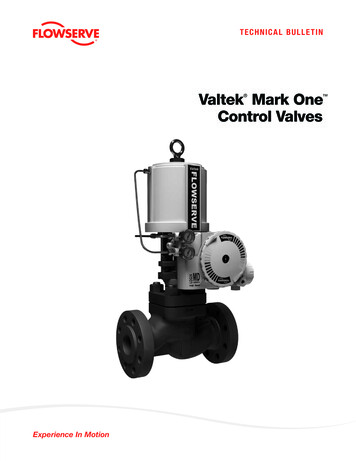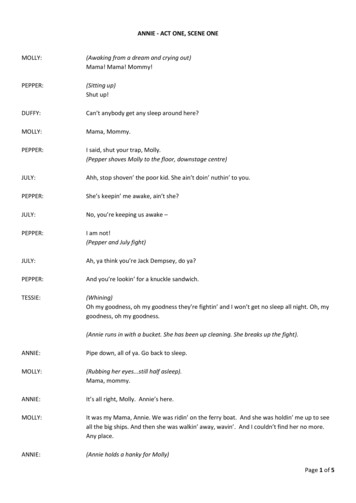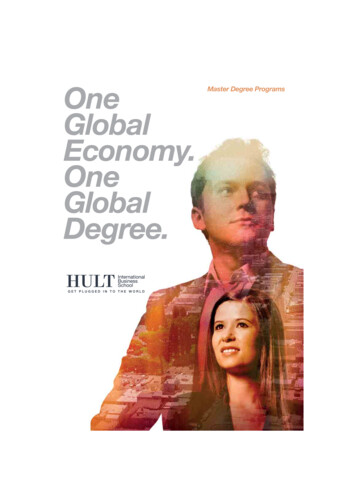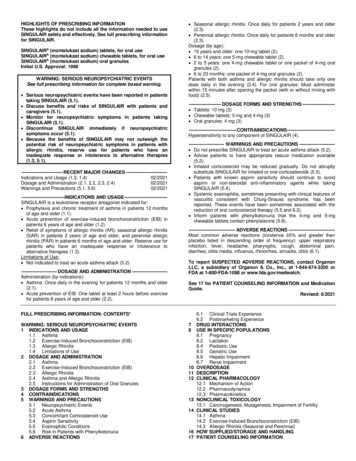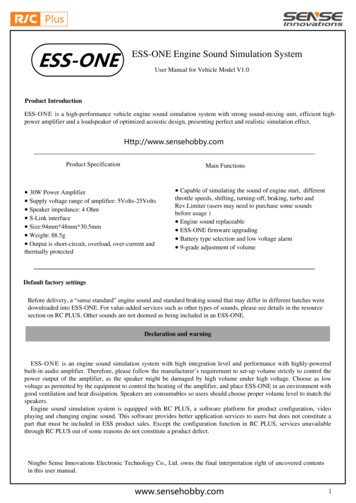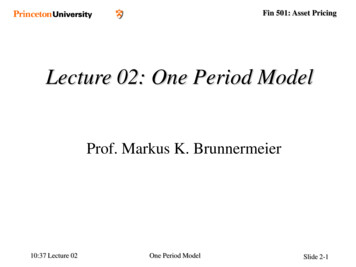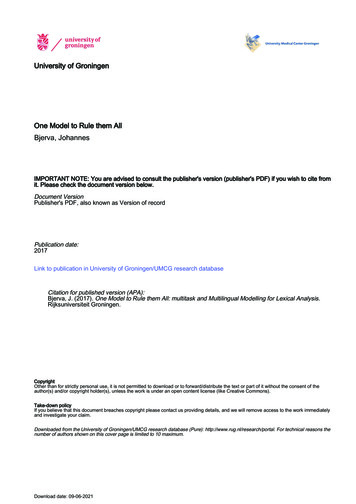
Transcription
University of GroningenOne Model to Rule them AllBjerva, JohannesIMPORTANT NOTE: You are advised to consult the publisher's version (publisher's PDF) if you wish to cite fromit. Please check the document version below.Document VersionPublisher's PDF, also known as Version of recordPublication date:2017Link to publication in University of Groningen/UMCG research databaseCitation for published version (APA):Bjerva, J. (2017). One Model to Rule them All: multitask and Multilingual Modelling for Lexical Analysis.Rijksuniversiteit Groningen.CopyrightOther than for strictly personal use, it is not permitted to download or to forward/distribute the text or part of it without the consent of theauthor(s) and/or copyright holder(s), unless the work is under an open content license (like Creative Commons).Take-down policyIf you believe that this document breaches copyright please contact us providing details, and we will remove access to the work immediatelyand investigate your claim.Downloaded from the University of Groningen/UMCG research database (Pure): http://www.rug.nl/research/portal. For technical reasons thenumber of authors shown on this cover page is limited to 10 maximum.Download date: 09-06-2021
One Model to Rule them allMultitask and Multilingual Modelling for Lexical AnalysisJohannes Bjerva
The work in this thesis has been carried out under the auspices of the Center forLanguage and Cognition Groningen (CLCG) of the Faculty of Arts of the Universityof Groningen.Groningen Dissertations in Linguistics 164ISSN: 0928-0030ISBN: 978-94-034-0224-6 (printed version)ISBN: 978-94-034-0223-9 (electronic version)c 2017, Johannes BjervaDocument prepared with LATEX 2ε and typeset by pdfTEX(Droid Serif and Lato fonts)Cover art: Cortical Columns. c 2014, Greg Dunn21K, 18K, and 12K gold, ink, and dye on aluminized panel.Printed by Off Page (www.offpage.nl) on G-print 115g paper.
One Model to Rule them allMultitask and Multilingual Modellingfor Lexical AnalysisProefschriftter verkrijging van de graad van doctor aan deRijksuniversiteit Groningenop gezag van derector magnificus prof. dr. E. Sterkenen volgens besluit van het College voor Promoties.De openbare verdediging zal plaatsvinden opdonderdag 7 december 2017 om 14.30 uurdoorJohannes Bjervageboren op 21 maart 1990te Oslo, Noorwegen
PromotorProf. dr. ing. J. BosCopromotorDr. B. PlankBeoordelingscommissieProf. dr. A. SøgaardProf. dr. J. TiedemannProf. dr. L. R. B. Schomaker
AcknowledgementsThis has been a bumpy ride, to say the least, and having reachedthe end of this four-year journey, I owe a debt of gratitude to all ofmy friends, family, and colleagues. Your support and guidance hascertainly helped smooth out most of the ups and downs I’ve experienced.First of all, I would like to thank my PhD supervisors. Johan, thefreedom you allowed me during the past four years has been one ofthe things I’ve appreciated the most in the whole experience. Thismeant that I could pursue the track of research I felt was the mostinteresting, without which writing a whole book would have beenmuch more arduous – thank you! Barbara, thank you for agreeing tojoin as co-supervisor so late in my project, and for putting in so muchtime during the last couple of months of my PhD. The thesis wouldlikely have looked quite different if you hadn’t started in Groningenwhen you did. I owe you a huge thanks, especially for the final weeks– reading and commenting on the whole thesis in less than 24 hoursduring your vacation. Just, wow!Next, I would like to thank Anders Søgaard, Jörg Tiedemann, andLambert Schomaker for agreeing to form my thesis assessment committee. I feel honoured that you took the time to read this thesis,and that you deemed it scientifically sound. I also want to thank everyone who I have collaborated with throughout these years, both inGroningen and in Stockholm. Thanks Calle for agreeing to work witha sign language novice such as myself. Raf, it was an enlightening
viexperience to work with you and see the world of ‘real’ humanitiesresearch. Robert, we should definitely continue with our one-weekshared task submissions (with various degrees of success).Most of the last few years were spent at the computational linguistics group in Groningen. I would especially like to thank all of myfellow PhD students throughout the years. Thanks Kilian, Noortje,Valerio, and Harm for welcoming me with open arms when I joinedthe group. Special thanks to Kilian for being so helpful with answering all of my billions and billions of questions involved in finishingthis thesis. Also, a special thanks to both Noortje and Harm for thetimes we shared when I had just moved here (especially that firstNew Year’s eve!). Hessel, thanks for all the help with administrative matters while I was abroad, especially for sending a gazillionof travel declarations for me. Rik and Anna, it was great getting toknow you both better during the last few months – hopefully youfind the bookmark to be sufficiently sloth-y. Dieke and Rob, thanksfor being such great laid back drinking buddies and travel companions. To all of you, and Pauline – I hope we will continue the tradition of going all out whenever I come to visit Groningen! A bigthanks to the rest of the computational linguistics group, especiallyGertjan, Malvina, Gosse, John, Leonie, and Martijn. Also thanks toall other PhD students who started with me: Luis, Simon, Raf, Ruben,Aynur, Jonne, and everyone else whose name I’ve failed to mention.A special thanks to Ben and Kaja - I hope we keep up our board-gamecentred visits to one another, no matter where we happen to pursueour careers.I spent most of my final year in Stockholm, and it was great beingin that relaxed atmosphere during one of the more intense periodsof the past few years. Most of all, I am sincerely grateful to Calle, toJohan (and Klara, Iris, and Vive), and to Bruno. Your support is trulyinvaluable, and by my lights, there is not much more to say than dank :(since a pal’s always needed). I’d also like to thank Johan and
viiCalle especially for agreeing to observing weird Dutch traditions bybeing my paranymphs. Josefina, Elísabet, and David, thank you allfor being there for me during the past year. Thanks to the computational linguistics group for hosting me during this period, especiallyMats, Robert, Kina, and Gintarė. Finally, thanks to everyone else atthe Department of Linguistics at Stockholm University.Having moved to Copenhagen this autumn has been an extremelypleasant experience. I would like to thank the entire CoAStal NLPgroup for simply being the coolest research group there is. Especially,I’d like to thank Isabelle for making the whole process of moving toDenmark so easy. Thanks to Anders, Maria, Mareike, Joachim, Dirk,and Ana for being so welcoming. I’d also like to thank everyone elseat the image section at DIKU, especially the running buddies at thedepartment, and most especially Kristoffer and Niels.Finally, I would like to thank my family. This bumpy ride wouldhave been challenging to get through without their support througheverything. Kiitos, mamma! Takk/tack Aksel, Paulina, Julian, ochLucas! Takk Olav, og takk Amanda!Let’s see where the journey goes next!Copenhagen, November 2017
ContentsContentsviii1 Introduction1.1 Chapter guide . . . . . . . . . . . . . . . . . . . . . . . .1.2 Publications . . . . . . . . . . . . . . . . . . . . . . . . .IBackground2 An Introduction to Neural Networks2.1 Introduction . . . . . . . . . . . . . . . . . . . . . .2.2 Representation of NNs, terminology, and notation2.3 Feed-forward Neural Networks . . . . . . . . . . .2.3.1 Feature representations . . . . . . . . . . .2.3.2 Activation Functions . . . . . . . . . . . . .2.3.3 Learning . . . . . . . . . . . . . . . . . . . .2.4 Recurrent Neural Networks . . . . . . . . . . . . .2.4.1 Long Short-Term Memory . . . . . . . . . .2.4.2 Common use-cases of RNNs in NLP . . . . .2.5 Convolutional Neural Networks . . . . . . . . . . .2.5.1 Local receptive fields . . . . . . . . . . . . .2.5.2 Weight sharing . . . . . . . . . . . . . . . .2.5.3 Pooling . . . . . . . . . . . . . . . . . . . . .2.6 Residual Networks . . . . . . . . . . . . . . . . . . .2.7 Neural Networks and the Human Brain . . . . . .2.8 Summary . . . . . . . . . . . . . . . . . . . . . . . .14611.13141517222324323639444546485051533 Multitask Learning and Multilingual Learning553.1 Multitask Learning . . . . . . . . . . . . . . . . . . . . . 56
Contents3.1.1 Non-neural Multitask Learning . . . . . . . . . .3.1.2 Neural Multitask Learning . . . . . . . . . . . . .3.1.3 Effectivity of Multitask Learning . . . . . . . . .3.1.4 When MTL fails . . . . . . . . . . . . . . . . . . .3.2 Multilingual Learning . . . . . . . . . . . . . . . . . . . .3.2.1 Human Annotation . . . . . . . . . . . . . . . . .3.2.2 Annotation Projection . . . . . . . . . . . . . . .3.2.3 Model Transfer . . . . . . . . . . . . . . . . . . .3.2.4 Model Transfer with Multilingual Input Representations . . . . . . . . . . . . . . . . . . . . . .3.2.5 Continuous Space Word Representations . . . . .3.3 Outlook . . . . . . . . . . . . . . . . . . . . . . . . . . . .ix5758626363656566676976II Multitask Learning794 Multitask Semantic Tagging4.1 Introduction . . . . . . . . . . . . . . . . . . . . . . . . .4.2 Semantic Tagging . . . . . . . . . . . . . . . . . . . . . .4.3 Method . . . . . . . . . . . . . . . . . . . . . . . . . . . .4.3.1 Inception model . . . . . . . . . . . . . . . . . . .4.3.2 Deep Residual Networks . . . . . . . . . . . . . .4.3.3 Modelling character information and residualbypass . . . . . . . . . . . . . . . . . . . . . . . .4.3.4 System description . . . . . . . . . . . . . . . . .4.4 Evaluation . . . . . . . . . . . . . . . . . . . . . . . . . .4.4.1 Experiments on semantic tagging . . . . . . . . .4.4.2 Experiments on Part-of-Speech tagging . . . . . .4.4.3 The Inception architecture . . . . . . . . . . . . .4.4.4 Effect of pre-trained embeddings . . . . . . . . .4.5 Discussion . . . . . . . . . . . . . . . . . . . . . . . . . .4.5.1 Performance on semantic tagging . . . . . . . . .4.5.2 Performance on Part-of-Speech tagging . . . . .4.5.3 Inception . . . . . . . . . . . . . . . . . . . . . . .81828387889090929596969698989899100
xContents4.5.4 Residual bypass . . . . . . . . . . . . . . . . . . . 1004.5.5 Pre-trained embeddings . . . . . . . . . . . . . . 1014.6 Conclusions . . . . . . . . . . . . . . . . . . . . . . . . . . 1015 Information-theoretic Perspectives on Multitask Learning5.1 Introduction . . . . . . . . . . . . . . . . . . . . .5.2 Information-theoretic Measures . . . . . . . . . .5.2.1 Entropy . . . . . . . . . . . . . . . . . . . .5.2.2 Conditional Entropy . . . . . . . . . . . . .5.2.3 Mutual Information . . . . . . . . . . . . .5.2.4 Information Theory and MTL in NLP . . .5.3 Data . . . . . . . . . . . . . . . . . . . . . . . . . .5.3.1 Morphosyntactic Tasks . . . . . . . . . . .5.3.2 Semantic Tasks . . . . . . . . . . . . . . .5.4 Method . . . . . . . . . . . . . . . . . . . . . . . .5.4.1 Architecture and Hyperparameters . . . .5.4.2 Experimental Overview . . . . . . . . . .5.4.3 Replicability and Reproducibility . . . . .5.5 Results and Analysis . . . . . . . . . . . . . . . . .5.5.1 Morphosyntactic Tasks . . . . . . . . . . .5.5.2 Language-dependent results . . . . . . . .5.5.3 Semantic Tasks . . . . . . . . . . . . . . .5.6 Conclusions . . . . . . . . . . . . . . . . . . . . . 18118118III Multilingual Learning1236 Multilingual Semantic Textual Similarity6.1 Introduction . . . . . . . . . . . . . . . . . .6.2 Cross-lingual Semantic Textual Similarity .6.3 Method . . . . . . . . . . . . . . . . . . . . .6.3.1 Multilingual word representations .6.3.2 System architecture . . . . . . . . . .6.3.3 Data for Semantic Textual Similarity125126128131131132135.
Contents6.4 Experiments and Results . . . . . . . . . . . . . . . . .6.4.1 Comparison with Monolingual Representations6.4.2 Single-source training . . . . . . . . . . . . . . .6.4.3 Multi-source training . . . . . . . . . . . . . . .6.4.4 Results on SemEval-2017 . . . . . . . . . . . . .6.4.5 Results on SemEval-2016 . . . . . . . . . . . . .6.5 Conclusions . . . . . . . . . . . . . . . . . . . . . . . . .xi.1351361371381401411427 Comparing Multilinguality and Monolinguality7.1 Introduction . . . . . . . . . . . . . . . . . . . . . . . . .7.2 Semantic Tagging . . . . . . . . . . . . . . . . . . . . . .7.2.1 Background . . . . . . . . . . . . . . . . . . . . .7.2.2 Data . . . . . . . . . . . . . . . . . . . . . . . . . .7.2.3 Method . . . . . . . . . . . . . . . . . . . . . . . .7.2.4 Experiments and Analysis . . . . . . . . . . . . .7.2.5 Summary of Results on Semantic Tagging . . . .7.3 Tagging Tasks in the Universal Dependencies . . . . . .7.3.1 Data . . . . . . . . . . . . . . . . . . . . . . . . . .7.3.2 Method . . . . . . . . . . . . . . . . . . . . . . . .7.3.3 Results and Analysis . . . . . . . . . . . . . . . .7.3.4 Summary of Results on the Universal Dependencies . . . . . . . . . . . . . . . . . . . . . . . . . .7.4 Morphological Inflection . . . . . . . . . . . . . . . . . .7.4.1 Method . . . . . . . . . . . . . . . . . . . . . . . .7.4.2 Results and Analysis . . . . . . . . . . . . . . . .7.4.3 Summary of Results on Morphological Inflection7.5 Estimating Language Similarities . . . . . . . . . . . . .7.5.1 Data-driven Similarity . . . . . . . . . . . . . . .7.5.2 Lexical Similarity . . . . . . . . . . . . . . . . . .7.5.3 Results and Analysis . . . . . . . . . . . . . . . .7.5.4 When is Multilinguality Useful? . . . . . . . . . .7.6 Conclusions . . . . . . . . . . . . . . . . . . . . . . . . . 64164165166167170171
xiiContentsIV Combining Multitask and Multilingual Learning1738 Multitask Multilingual Learning8.1 Combining Multitask Learning and Multilinguality8.2 Data . . . . . . . . . . . . . . . . . . . . . . . . . . .8.2.1 Labelled data . . . . . . . . . . . . . . . . .8.2.2 Unlabelled data . . . . . . . . . . . . . . . .8.3 Method . . . . . . . . . . . . . . . . . . . . . . . . .8.3.1 Architecture . . . . . . . . . . . . . . . . . .8.3.2 Hyperparameters . . . . . . . . . . . . . . .8.4 Experiments and Analysis . . . . . . . . . . . . . .8.5 Discussion . . . . . . . . . . . . . . . . . . . . . . .8.6 Conclusion . . . . . . . . . . . . . . . . . . . . . . .V Conclusions9 Conclusions9.1 Part II - Multitask Learning . . . . . . . .9.2 Part III - Multilingual Learning . . . . .9.3 Part IV - Combining Multitask Learningguality . . . . . . . . . . . . . . . . . . . .9.4 Final words . . . . . . . . . . . . . . . . .175176179179180181181181182193195197. . . . .and. . . . .199. . . . . . 199. . . . . . 201Multilin. . . . . . 202. . . . . . 203Appendices205A Correlation figures for all languages in Chapter 5207B Bibliographical ing243
CHAPTER 1IntroductionWhen learning a new skill, you take advantage of your preexistingskills and knowledge. For instance, if you are a skilled violinist, youwill likely have an easier time learning to play cello. Similarly, whenlearning a new language you take advantage of the languages youalready speak. For instance, if your native language is Norwegianand you decide to learn Dutch, the lexical overlap between these twolanguages will likely benefit your rate of language acquisition. Thisthesis deals with the intersection of learning multiple tasks and learning multiple languages in the context of Natural Language Processing(NLP), which can be defined as the study of computational processingof human language. Although these two types of learning may seemdifferent on the surface, we will see that they share many similarities.Traditionally, NLP practitioners have looked at solving a singleproblem for a single task at a time. For instance, considerable timeand effort might be put into engineering a system for part-of-speech(PoS) tagging for English. However, although the focus has been onconsidering a single task at a time, fact is that many NLP tasks arehighly related. For instance, different lexical tag sets will likely exhibit high correlations with each other. As an example, consider the
21. Introductionfollowing sentence annotated with Universal Dependencies (UD) PoStags (Nivre et al., 2016a), and semantic tags (Bjerva et al., 2016b).1,2(1.1) WePRONthisDETmustAUXformNOUNdraw attention to the distribution ofVERB NOUNADP DET NOUNADPin those dialects .ADP DETNOUNPUNCT(1.2) We must draw attention to the distribution ofPRO NEC EXSCONREL DEF CONANDthis form in those dialects .PRX CON REL DSTCONNILWhile these tag sets are certainly different, the distinctions they makecompared to one another in this example are few, as there are onlytwo apparent systematic differences. Firstly, the semantic tags offera difference between definite (DEF), proximal (PRX), and distal determiners (DST), whereas UD lumps these together as DET (highlightedin green). Secondly, the semantic tags also differentiate between relations (REL) and conjunctions (AND), which are both represented bythe ADP PoS tag, highlighted in blue. Hence, although these tasks areundoubtedly different, there are considerable correlations betweenthe two, as the rest of the tags exhibit a one-to-one mapping in this example. This raises the question of how this fact can be exploited, asit seems like a colossal waste to not take advantage of such inter-taskcorrelations. In this thesis I approach this by exploring multitasklearning (MTL, Caruana, 1993; 1997), which has been beneficial formany NLP tasks. In spite of such successes, however, it is not clearwhen or why MTL is beneficial.1PMB 01/3421. Original source: Tatoeba. UD tags obtained using UD-Pipe(Straka et al., 2016)2The semantic tag set consists of 72 tags, and is developed for multilingualsemantic parsing. The tag set is described further in Chapter 4.
3Similarly to how different tag sets correlate with each other, languages also share many commonalities with one another. These resemblances can occur on various levels, with languages sharing, forinstance, syntactic, morphological, or lexical features. Such similarities can have many different causes, such as common language ancestry, loan words, or being a result of universals and constraints inthe properties of natural language itself (see, e.g., Chomsky,2005, andHauser et al., 2002). Consider, for instance, the following Germantranslation of the previous English example, annotated with semantic tags.3(1.3) Wir müssen die Verbreitung dieser Form in diesenPRO NECDEF CONPRXCONREL PRXDialekten beachten .CONEXSNILComparing the English and German annotations, there is a high overlap between the semantic tags used, and a high lexical overlap. As inthe case of related NLP tasks, this begs the question of how multilinguality can be exploited, as it seems like an equally colossal waste tonot consider using, e.g., Norwegian PoS data when training a SwedishPoS tagger. There are several approaches to exploiting multilingualdata, such as annotation projection and model transfer, as detailedin Chapter 3. The approach in this thesis is a type of model transfer, in which such inter-language relations are exploited by exploringmultilingual word representations, which have also been beneficialfor many NLP tasks. As with MTL, in spite of the fact that such approaches have been successful for many NLP tasks, it is not clear inwhich cases it is an advantage to go multilingual.Given the large amount of data available for many languages indifferent annotations, it is tempting to investigate possibilities of com3PMB 01/3421. Original source: Tat
Other than for strictly personal use, it is not permitted to download or to forward/distribute the text or part of it without the consent of the author(s) and/or copyright holder(s), unless the work


